IT was with high expectations that I arrived at the Gunung Mulu National Park on the Malaysian side of Borneo Island. I knew that it is a Unesco World Heritage
Site, one of only two in Malaysia.
 I had seen those famous pictures of a perplexing, alien, Krypton-like landscape of 50-metre tall jagged limestone spears piercing through a lush green forest canopy. I had taken for granted oftrepeated superlative descriptions like "The world's largest cave chamber!", "The world's biggest underground cave passage!", "The most spectacular bat exodus", etc.
I had seen those famous pictures of a perplexing, alien, Krypton-like landscape of 50-metre tall jagged limestone spears piercing through a lush green forest canopy. I had taken for granted oftrepeated superlative descriptions like "The world's largest cave chamber!", "The world's biggest underground cave passage!", "The most spectacular bat exodus", etc.
I had six days and I had planned to see the show caves, catch the bat exodus, climb to the Pinnacles and cap the trip with a grand finale of adventure caving. About an hour into the Pinnacles trail, as I was hauling myself up 60 degree slopes with laboured breath and burning thighs, I realised to my dismay that that was perhaps an overly ambitious itinerary for my current physical condition.
My travel companion, Jacqui, is an old friend from England who had cycled uphill to work everyday for a month to train for this trip, a fitness regime that I was
profoundly thankful she subscribed to when she offered to carry my clothes, food and water. For a moment, I felt guilty until I realised that the additional weight was inconsequential to her because she quickly disappeared round the next bend and continued to tear effortlessly up the mountain.
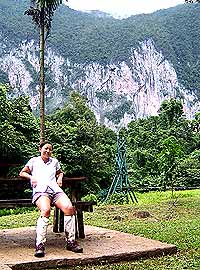 According to the brochure I had picked up at the park headquarters, the trek to the Pinnacles begins with what is supposed to be a leisurely and gradient-free half-day walk to Camp 5, the base camp for the Pinnacles ascent. I imagined that it would indeed have been a lovely stroll in the woods if not for the series of mud baths which they had neglected to mention in the glossy brochure and which we found ourselves unwittingly plunging into every few hundred metres.
According to the brochure I had picked up at the park headquarters, the trek to the Pinnacles begins with what is supposed to be a leisurely and gradient-free half-day walk to Camp 5, the base camp for the Pinnacles ascent. I imagined that it would indeed have been a lovely stroll in the woods if not for the series of mud baths which they had neglected to mention in the glossy brochure and which we found ourselves unwittingly plunging into every few hundred metres.
Awesome power
Mulu receives an unusually high annual rainfall of five to six metres and the same rain that soaked the earth and flooded our path possesses a potent dissolving power that sculpts the Pinnacles and a mighty erosive force that carves the endless maze of caverns and passages of Mulu. That evening as we settled down at Camp 5, I witnessed the awesome power of the Mulu rain as the sky emptied itself in a marathon torrential downpour that lasted till dawn. It was unlike any rain that I had seen in all my years living in Malaysia.
We found our native guide who was to take us up Gunung Api (1,682m), home
to the Pinnacles, and above the roar of the storm, we struggled to make out his
mumbled instructions. Finally we understood that we were to start our trek at
6.30am because we have to reach some "first ladder" by 11am and each
person was to bring at least three litres of water.
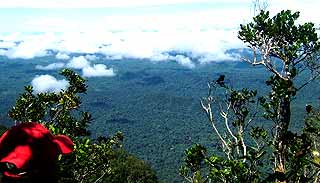 Perhaps we had misheard our guide's instructions or perhaps it had something to do with the bottle of Scotch that was being passed around among the guides the night before but on the following morning we had to wait for an hour before our guide appeared.
Perhaps we had misheard our guide's instructions or perhaps it had something to do with the bottle of Scotch that was being passed around among the guides the night before but on the following morning we had to wait for an hour before our guide appeared.
The trail soggy from the rain climbed steeply early in our journey. Mulu is prized both for its astounding karst features as well as its rich biodiversity, exhibiting some 3,500 species of plants, 170 species of wild orchids, 10 species of pitcher plants, 281 species of butterfly, 458 species of ants, 262 species of birds and a bewildering 2000 species of moth! But frankly speaking, all these details became lost in the featureless canvas of green surrounding me as my entire consciousness narrowed to the singular, all-consuming task of putting one foot ahead of the other.
At a little passed 10am, we arrived at the "first ladder", that is the first in a
column of ladders to aid our climb up near vertical rocky outcrops. Hikers who
arrive at this point beyond 11am are warned to turn back or risk not getting down from the mountain before dark. I suddenly came alive at this part of the trek because I enjoy rock climbing and had done a fair share in my youthful and fitter days. So I spent the next hour and a half energetically scrambling over rocks, shinnying up ladders and swinging on ropes.
My consciousness expanded and I took in pitcher plants, wild orchids, the rare One-leaf plant and my heart soared at the rare and magnificent sight of hectares and hectares of unbroken canopies of the greenest, lushest rainforest that I have ever seen. I took a deep breath and seared the scene into my memory because it occurred to me that this corner of Borneo represents creation in its original state and I do not know for how long more this piece of heritage will remain untouched.
 Our brochure told us that "fit, experienced trekkers may reach the top in 2-3
Our brochure told us that "fit, experienced trekkers may reach the top in 2-3
hours, the not so fit around 4-5 hours". Our time of 4.5 hours firmly put us in the not-so-fit category. Perhaps it was this upsetting revelation that caused our anti-climactic reception of the Pinnacles when we finally caught sight of them. Or perhaps we were just tired and our senses were numbed by the arduous climb.
Or perhaps it was our lack of appreciation for the mysterious geomorphologic
forces and processes that have been at work for 1.5 million years in fashioning
these curious-looking limestone towers.
Deepening my appreciation
I wanted to learn more about their origin and evolution to deepen my appreciation of this place but our guide was already snoozing in the cradle of a branch. The pictures I had seen of the Pinnacles particularly those taken from a bird's eye view were stunning but as I stood absorbing the view, I was surprised and slightly disappointed to note that the Pinnacles that I had seen in those pictures looked more impressive than they did from where I was standing. Now if only I could get on a helicopter and get a sweeping view of them
Our journey down was a knee-jarring five-and-a-half hours on the same steep
slopes that we came up on. With an hour to reach Camp 5, the skies reopened
and unloaded torrents so we clung frantically to trunks, branches and roots for
support while inching, bumping and sliding our way down. But of course in typical irony, the rain stopped the moment we arrived at the camp,
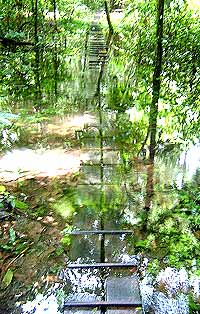 We spent the night resting our limp legs and recharging on instant pasta and hot milo while doing our best to conceal our envy of the other groups who had paid for the luxury of a guide-cum-chef to whip up full-fledged dinners of rice, meat and fresh local ferns (and thereafter wash the dishes!).
We spent the night resting our limp legs and recharging on instant pasta and hot milo while doing our best to conceal our envy of the other groups who had paid for the luxury of a guide-cum-chef to whip up full-fledged dinners of rice, meat and fresh local ferns (and thereafter wash the dishes!).
There was also a team of professional-looking British cavers who were busy poring over charts, laptops and an array of electronic gadgetry. I heard that they have just discovered 20km of new cave passages. That is 25km to add to over 300km of known and explored passages in Mulu. So the earth continues to yield her subterranean secrets to men who are brave enough to spend weeks and even months on end crawling through guano (bat droppings) and squeezing through claustrophobic crevices to locate virgin cave systems and plumb their depths.
That reminded me that crawling in guano and squeezing through crevices, also called adventure caving, was precisely what we had booked ourselves into when we head back to the park headquarters the following day. An assessment of my excruciatingly sore and bruised legs quickly ruled that out and I shamefully cancelled my booking. Instead, as a reward for all our hard work, Jacqui and I checked into the Royal Mulu Resort and booked ourselves for a full body massage at their spa, which we both agreed was an excellent alternative to adventure caving!
We then took a leisurely stroll to the entrance of Deer Cave on a path neatly lined with boardwalks in hope of catching the bat exodus. We had come here on our first evening in Mulu but the bats did not leave the cave that evening. After over 30 years of observing them, scientists are still unable to determine when or why bats do not leave the caves on rare occasions.
Surprisingly orderly exodus
Deer Cave is the largest underground river passage in the world. Its sheer size allows it to harbour at least 3 million Wrinkle-Lipped bats (as well as a jumbo jet if the need ever arises) and it is getting bigger every day as rain continues to eat away the limestone that forms the walls of the caves. At about 5.30pm, the first group of bats streamed out of the cave. In my mind, I had expected to see a chaotic mass of wings simultaneously exploding from the cave but what emerged was a surprisingly orderly exodus. Tens of small groups exited minutes apart one after another and this lasted for about half an hour.
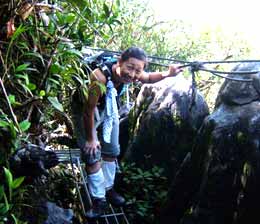 I wondered if the bats have a queuing system to this large-scale exercise, how the they determine who goes into which group, which group leaves first and if they stay in the same group every time. I marvelled at the first-rate coordination skills that these bats must possess in order to organise themselves, all three million of them, into orderly groups for a systematic exodus.
I wondered if the bats have a queuing system to this large-scale exercise, how the they determine who goes into which group, which group leaves first and if they stay in the same group every time. I marvelled at the first-rate coordination skills that these bats must possess in order to organise themselves, all three million of them, into orderly groups for a systematic exodus.
A park ranger who was sitting beside me told me that soon we may find answers to these questions that scientists have also been asking for decades when the park embarks on an impressive project to rig cameras inside the cave. And since the signals will be broadcasted "live" onto big screens at the Bat Observatory, for the first time ever, visitors to Mulu will be able to watch the activity of the bats as they prepare for the exodus and will also know in advance if the bats intend to take the day off! I think that this is such an excellent educational tool that will offer another dimension to the bat spectacle and make a bat appreciator out of the most nonchalant visitor.
In the open sky, each group of bats twist and turn to morph into dramatic helixand doughnut-shaped configurations. This is a clever trick of the bats to confuse their preying predators such as the falcons, hawks and eagles which circle in waiting every evening. The bats leave the safety of the caves almost every evening to hunt for insects in the forest with each bat consuming five to 10 grams of insects.
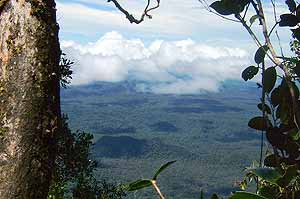 Most of this ends up on the cave floor as guano which in an environment deprived of sunlight and plant life, forms an important food source for other cave dwellers. Inside Deer Cave, there is a 100 metre high mound of guano covered by a carpet of cockroaches that feeds on the nutrients of these digestive remains and in turn become food for other cave-dwelling creatures. So, even detestable roaches have a purpose in this dark scheme of things.
Most of this ends up on the cave floor as guano which in an environment deprived of sunlight and plant life, forms an important food source for other cave dwellers. Inside Deer Cave, there is a 100 metre high mound of guano covered by a carpet of cockroaches that feeds on the nutrients of these digestive remains and in turn become food for other cave-dwelling creatures. So, even detestable roaches have a purpose in this dark scheme of things.
After the last group of bats disappeared into the distant sky, we walked back to
our chalet in the dark and I noticed for the first time that the beetles and
grasshoppers in this part of the world are of gargantuan proportions in
comparison to their urban cousins.
Studying the ants
The next afternoon, we signed up for a tour of the Deer and Lang show caves.
This time, our guide was a punctual, enthusiastic and informative young man
called Henry. He took us on the same route that we taken twice before to watch the bats. But this time the thick green canvas that I had taken for granted came alive as he pointed out hidden microcosms such as the ant-rattan symbiosis. The rattan palm provides a suitable habitat for the ants to nest while the ants protect the rattan from foraging herbivores. You do not see the ants because they occupy micro chambers within the rattan stem but you can hear them when you shake the stem.
 Our guide explained that when the ants feel agitated, they knock their heads against the stem and the collective knocking of thousands of ants emit a loud rustling sound. I heard it and it was an unexpectedly beautiful sound with an ethereal timbre to it like wind whispering through bamboo leaves.
Our guide explained that when the ants feel agitated, they knock their heads against the stem and the collective knocking of thousands of ants emit a loud rustling sound. I heard it and it was an unexpectedly beautiful sound with an ethereal timbre to it like wind whispering through bamboo leaves.
He also showed us a messy corner of the forest where a large ancient tree had been toppled by a recent storm. The cavity left by the uprooted base is now filled with rain water forming a little pond in which an entire new ecosystem has sprung to life. And it is for the very purpose of creation and preservation of new life that toppled trees and messy patches like this are never cleaned up in this national park.
As we were finishing the tour of the show caves and coming out into the sunlight, I heard a faint drone overhead and I looked up to see a band of bats spiralling out of the cave entrance. Once again, it was time for the bat exodus and this time, the bats did not emerge in small groups but came out in an unceasing stream that remained uninterrupted for half an hour. This majestic aerial performance perfectly capped a trip that has given me a tremendous appreciation of the rainforest.
I understood the meaning of "web of life" in the many instances that I had caught glimpses of how every thing, down to the cockroach and guano, has a purpose and a place beyond its sole existence that is designed to proliferate and support the life of other living beings. I had spent many moments marvelling incredulously at the intelligent design that is built into every biological system in the jungle and I promise myself that the next time that I come to Mulu, I will not bother to climb any mountains but will just devote time to discovering the thinly veiled secret designs of this abundant, amazing web of life.
And I am feeling absolutely proud that Malaysia has safeguarded this wonderful
showcase of creation so well.
Photos by Jacqui Chan
SHIRENE CHEN is a restless pilgrim taking a rest from the corporate world to read, write and live. Comments can reach rentakini by emailing [email protected]

